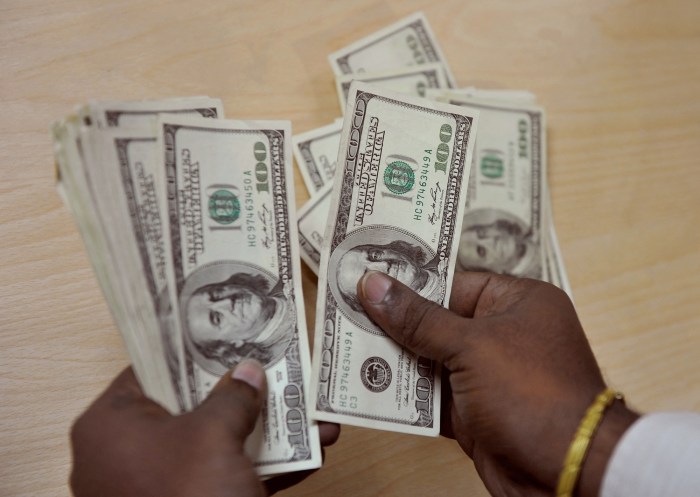How much money Americans need to feel rich is a complex question, delving into the heart of American culture and psychology. It explores the evolving definition of wealth, from historical perspectives to current social pressures. This exploration examines economic factors like income and savings, alongside non-economic influences such as social status and personal values. Ultimately, it investigates the correlation between income levels, lifestyle choices, and the subjective experience of feeling rich.
The journey begins with a historical analysis of how the concept of wealth has evolved in the US. Cultural factors are examined, along with the differences between objective measures of wealth and the subjective feeling of richness. Various demographics will be compared, showing how age, income, and location impact their perception of “feeling rich.” The analysis then shifts to the economic and non-economic elements contributing to these feelings, and the role of social comparison and societal pressures.
This is further illuminated by a deep dive into income levels and their relation to perceived richness, including relative income and its impact. Finally, lifestyle choices, spending habits, and the influence of social media are considered, along with the psychological factors like self-esteem and personal values that shape the experience of feeling rich.
Defining “Rich” in American Culture
The American dream, often intertwined with the concept of wealth, has undergone significant transformations throughout history. Early notions of wealth centered around land ownership and agricultural success, evolving later to include industrial ventures and entrepreneurial pursuits. Today, wealth is more multifaceted, encompassing diverse assets like stocks, real estate, and intellectual property. This shift reflects a dynamic economy and evolving societal values.Understanding how Americans perceive “rich” requires delving into the cultural factors shaping this perception.
Materialism, fueled by consumerism and the pervasive influence of advertising, plays a significant role. The emphasis on acquiring possessions, showcasing success, and keeping up with societal standards contributes to the subjective nature of feeling rich.
Historical Evolution of Wealth Perception
The concept of wealth in America has evolved from agrarian roots to the modern, diversified economy. Early settlers valued land and agricultural output. The Industrial Revolution brought forth new avenues for wealth accumulation, with entrepreneurs and industrialists emerging as prominent figures. The 20th century witnessed the rise of the middle class and a shift towards white-collar jobs and professional services.
Figuring out how much money Americans need to feel rich is a tricky question, isn’t it? It’s probably more about lifestyle and perspective than a specific dollar amount. Maybe a stay at a luxurious hotel, like the Steve Irwin family’s hotel at Australia Zoo hotels resorts steve irwin family hotel australia zoo , would make some feel rich.
Ultimately, though, “rich” is a very personal feeling.
Today, the definition of wealth encompasses not only material possessions but also financial security, freedom, and personal fulfillment.
Cultural Factors Influencing Perceptions of Wealth
American culture is deeply influenced by individualism, meritocracy, and a strong work ethic. These values contribute to the belief that hard work and determination are crucial for achieving wealth. Consumerism, with its constant barrage of advertisements and aspirational lifestyles, further shapes perceptions of wealth. The pressure to acquire material possessions and keep up with social trends significantly impacts how Americans define and experience “feeling rich.”
Objective vs. Subjective Measures of Wealth
Objective measures of wealth, such as net worth, are quantified and easily measured. Subjective feelings of richness, however, are more complex and influenced by various factors. A person with a high net worth might not feel rich if they perceive their expenses to be overwhelming, or if their lifestyle doesn’t align with their aspirations. Conversely, someone with a modest net worth could feel a strong sense of richness based on their values, personal relationships, and financial security.
Different Ways Americans Define “Feeling Rich”
Americans experience “feeling rich” in diverse ways. For some, it’s about a specific lifestyle, encompassing experiences, travels, and the ability to indulge in luxuries. Others equate richness with financial security, ensuring stability for themselves and their loved ones. Still others associate richness with freedom, the ability to make choices without financial constraints and pursue personal goals.
Demographic Variations in Perceptions of “Feeling Rich”
Different demographics perceive “feeling rich” differently. Younger generations, often burdened with student loan debt and a more competitive job market, might define richness differently compared to older generations who have accumulated more assets over their careers. Income levels also play a crucial role. Someone earning a high salary might still feel financial pressure, while someone with a modest income might experience a strong sense of richness based on their financial security.
Geographic location significantly influences perceptions, as cost of living varies drastically across the country.
Demographic Analysis of “Feeling Rich”
| Demographics | Definition of Rich | Expected Income Level (USD) |
|---|---|---|
| Young Adults (18-35) | Financial freedom, ability to pursue passions, comfortable lifestyle. | $60,000 – $100,000 |
| Middle-Aged Adults (36-55) | Financial security, comfortable retirement plan, ability to provide for family. | $80,000 – $150,000 |
| Older Adults (56+) | Financial independence, freedom from daily work pressures, secure retirement. | $70,000 – $180,000 |
| High-income earners | Luxury lifestyle, international travel, high-end possessions. | $150,000+ |
| Low-income earners | Financial stability, ability to meet basic needs, freedom from debt. | $25,000 – $40,000 |
Factors Influencing Perceived Wealth
Defining “rich” is a deeply personal and culturally shaped experience. While financial metrics like income and assets play a role, a multitude of other factors contribute to the subjective feeling of wealth. Beyond the balance sheet, perceptions are often tied to social standing, personal values, and the lifestyles we choose.The quest for financial security and the feeling of “being rich” is multifaceted.
It’s not simply about accumulating wealth; it’s about how that wealth is perceived and experienced. This exploration delves into the key economic and non-economic elements that influence the subjective experience of wealth.
Economic Factors Contributing to Feelings of Richness, How much money americans need to feel rich
Understanding the economic factors that contribute to the feeling of richness is crucial to comprehending the multifaceted nature of this perception. Income, savings, and investments directly impact the financial security and potential for future prosperity, which are often seen as crucial elements in defining a person’s wealth.
- Income: A higher income allows for greater purchasing power and a wider range of lifestyle choices. This often leads to a sense of financial freedom and the ability to meet immediate and future needs with ease.
- Savings: Savings represent a buffer against unexpected expenses and a foundation for future financial goals. A healthy savings rate can provide a sense of security and confidence in one’s financial future.
- Investments: Strategic investments can yield significant returns over time, amplifying financial security and creating the potential for substantial wealth accumulation. The potential for growth and appreciation is often linked to a feeling of financial prosperity.
Non-Economic Factors Contributing to Feelings of Richness
Beyond the purely financial aspects, non-economic factors play a vital role in shaping perceptions of wealth. These factors are deeply personal and often influenced by individual values and experiences.
- Social Status: Social standing, including occupation, network, and community influence, can contribute significantly to the feeling of wealth. High social status often comes with recognition, opportunities, and a sense of belonging, which can be deeply satisfying.
- Personal Values: Individuals’ values significantly impact their perception of wealth. Someone who prioritizes experiences over material possessions might find fulfillment in travel and cultural enrichment, even with limited financial resources.
- Lifestyle Choices: Choices regarding housing, transportation, and leisure activities contribute to the feeling of richness. A lifestyle aligned with one’s values and aspirations can create a profound sense of contentment and well-being.
Role of Social Comparison in Shaping Perceptions of Wealth
Social comparison is a powerful force in shaping perceptions of wealth. Comparing oneself to others can lead to feelings of inadequacy or satisfaction, depending on the outcome.
- Social Comparison: The constant comparison to others’ perceived success and lifestyles can significantly impact an individual’s feelings about their own wealth. Seeing others with more extravagant possessions or seemingly effortless prosperity can lead to feelings of inadequacy.
Societal Pressures and Media Portrayals
Societal pressures and media portrayals significantly influence perceptions of wealth. These factors can shape expectations and desires, often leading to unrealistic standards.
- Societal Pressures: Societal norms and expectations can create pressure to conform to a specific lifestyle that often equates with wealth. This pressure can contribute to feelings of inadequacy if one cannot meet those expectations.
- Media Portrayals: Media portrayals often present idealized images of wealth, creating unrealistic expectations and desires. These portrayals can lead to dissatisfaction with one’s own financial situation and feelings of inadequacy.
Table: Factors Influencing Perceived Wealth
| Factor | Description | Impact on Feeling Rich |
|---|---|---|
| Income | Amount of money earned | Higher income often correlates with greater financial security and freedom |
| Savings | Money saved and accumulated | Provides a safety net and contributes to a sense of financial security |
| Investments | Assets invested for growth | Potential for increased wealth and future financial stability |
| Social Status | Position and standing in society | Recognition, opportunities, and sense of belonging |
| Personal Values | Individual beliefs and priorities | Influence on what constitutes wealth and fulfillment |
| Lifestyle Choices | Decisions about housing, travel, etc. | Alignment with values and aspirations can lead to contentment |
| Social Comparison | Comparing oneself to others | Can lead to feelings of inadequacy or satisfaction |
| Societal Pressures | Expectations from society | Can create pressure to conform to a specific lifestyle |
| Media Portrayals | How wealth is depicted in media | Often creates unrealistic expectations and desires |
Income Levels and Feelings of Richness
The pursuit of financial security and the perception of being “rich” are deeply intertwined with individual income levels and societal factors. Understanding how income translates into feelings of richness requires delving into the complexities of personal finance, happiness, and the ever-present comparison game. This exploration examines the relationship between income levels and perceived wealth, highlighting the psychological impact of earnings and the role of relative income in shaping these perceptions.
Average Income Levels in the US
Data from the U.S. Census Bureau provides insights into average income levels across different demographic groups and socioeconomic strata. Understanding these averages is crucial for contextualizing the correlation between income and feelings of richness. Income figures vary significantly based on factors like age, education, occupation, and location.
Figuring out how much money Americans need to feel rich is tricky, isn’t it? It’s definitely not a fixed number. Maybe a lavish Disney cruise, like a voyage on the Disney Wish, cruises disney cruises disney wish cruise , could contribute to that feeling of affluence for some. But ultimately, it’s a very personal and subjective experience, isn’t it?
Correlation Between Income and Perceived Richness
Empirical research suggests a complex relationship between income and feelings of richness. While higher incomes generally correlate with a greater sense of financial security and comfort, the relationship is not linear. The transition from feeling “comfortable” to feeling “rich” often involves more than just increased earnings; it also depends on expectations, lifestyle, and societal norms.
Psychological Impact of Income on Happiness and Well-being
Research consistently demonstrates a positive correlation between income and happiness, up to a certain point. Beyond a basic level of security, the impact of additional income on happiness tends to diminish. Factors like social connections, purpose, and personal values often play a more significant role in overall well-being than income alone.
Relative Income and Perceptions of Richness
The concept of relative income highlights the crucial role of comparison in shaping perceptions of wealth. Even individuals with high absolute incomes may feel relatively poor if their peers or social circles have significantly higher earnings. This comparison effect can significantly impact the subjective experience of wealth and financial security.
Table: Income Brackets, Perceived Richness, and Supporting Details
| Income Bracket | Average Perceived Richness Score (Hypothetical) | Supporting Details |
|---|---|---|
| $0 – $30,000 | 2/10 | Often struggle to meet basic needs; financial insecurity is prevalent. |
| $30,000 – $60,000 | 4/10 | May have some financial cushion but still susceptible to economic shocks; more likely to experience stress. |
| $60,000 – $100,000 | 6/10 | Generally comfortable financially; have more choices and opportunities; increased security. |
| $100,000 – $200,000 | 8/10 | Significant financial freedom; able to meet most desires and pursue significant investments. |
| $200,000+ | 9/10 | High level of financial security and freedom; able to pursue luxurious lifestyle choices. Relative comparisons with others in similar income brackets still play a role. |
Note: The “Average Perceived Richness Score” in the table is a hypothetical illustration. Actual scores would vary greatly based on numerous factors and individual circumstances.
Lifestyle Choices and Perceived Wealth
The pursuit of perceived wealth is often intertwined with lifestyle choices. From the homes we inhabit to the vacations we take, our spending habits can significantly impact how we feel about our financial standing. This interplay between material possessions and self-perception is a complex one, shaped by cultural norms, personal values, and the ever-present influence of social comparison.Beyond the purely financial, lifestyle choices reflect aspirations, values, and social standing.
The perceived worth of a certain lifestyle can vary dramatically between individuals and across different social groups, leading to a complex and nuanced understanding of how we define richness. These perceptions are not always objective and are influenced by a myriad of factors, including social media, advertising, and personal experiences.
Impact of Housing on Perceived Wealth
Owning a large, luxurious home is frequently associated with wealth in many cultures. The size, location, and architectural style of a residence can greatly influence how individuals perceive their own financial status. A sprawling estate in a prestigious neighborhood might be seen as a symbol of substantial wealth, while a smaller, more modest home in a less affluent area might evoke a different feeling of financial security.
This is not to say that the size of the home directly dictates the wealth of the occupant, but rather that the perceived value of the home contributes to the perception of richness.
Influence of Travel and Experiences on Feelings of Richness
Travel and leisure activities play a crucial role in shaping perceptions of wealth. Experiencing exotic destinations, indulging in high-end accommodations, or participating in lavish activities like private jet travel can create a feeling of richness and privilege. These experiences, however, are not necessarily indicative of overall wealth, as the cost of such experiences can be significant without a corresponding impact on one’s overall financial situation.
The perceived value of these experiences is often subjective and influenced by personal preferences and cultural norms.
Spending Habits and Feelings of Richness
Spending habits are directly correlated with feelings of richness. The way individuals allocate their resources—whether on necessities, luxury items, or charitable contributions—reflects their priorities and values. A person who prioritizes experiences over material possessions might feel rich from engaging in activities they find fulfilling, while someone focused on acquiring expensive goods might derive a sense of richness from the possession of these items.
The link between spending and feelings of richness is multifaceted and influenced by individual preferences and cultural norms.
Social Group Comparisons and Perceptions of Wealth
Perceptions of wealth vary across different social groups. What might be considered lavish spending in one social circle could be considered frugal in another. Factors such as education, occupation, and family background influence the standards of comparison and the perception of what constitutes “rich.” These varying perceptions can lead to feelings of inadequacy or superiority depending on an individual’s place within a given social group.
For example, a professional in a high-income industry might feel less rich compared to a multi-millionaire but more rich than someone in a lower-income job.
Social Media’s Role in Shaping Perceptions of Richness
Social media platforms often showcase idealized lifestyles, presenting a curated view of wealth and success. Individuals may feel pressured to maintain a certain image of richness, leading to unrealistic expectations and potentially negative comparisons. The carefully crafted narratives on social media can distort perceptions of reality and fuel a sense of dissatisfaction with one’s own lifestyle. The constant exposure to these often-misleading portrayals can lead to feelings of inadequacy and a distorted view of what constitutes a rich life.
Lifestyle Choices, Perceived Value, and Correlation to Feeling Rich
| Lifestyle Choice | Perceived Value | Correlation to Feeling Rich |
|---|---|---|
| Luxury Housing | High | Strong |
| High-End Travel | High | Moderate to Strong |
| Luxury Consumption (e.g., designer goods) | High | Moderate |
| Experiential Travel | Moderate to High | Moderate to Strong |
| Giving Back to Community | High (for some) | Moderate to Strong (often tied to personal values) |
Psychological Aspects of Feeling Rich
The pursuit of wealth often transcends mere financial gain. It delves into the intricate realm of personal perception and psychological well-being. Feeling rich isn’t solely about the size of one’s bank account; it’s deeply intertwined with self-perception, values, and the overall quality of life. This exploration delves into the psychological underpinnings of financial contentment, moving beyond the material to examine the emotional and mental factors that contribute to a sense of richness.Feeling rich is significantly influenced by subjective experiences and internal states.
It’s not a direct correlation with income, but rather a complex interplay of factors, including self-esteem, personal values, and the ability to find fulfillment in various aspects of life. The following sections will illuminate the psychological drivers behind this complex relationship.
Self-Esteem and Personal Values
Individual self-worth plays a crucial role in shaping one’s perception of wealth. People with higher self-esteem often experience a greater sense of financial security and well-being, regardless of their actual income. Their internal valuation of their worth is independent of material possessions. Conversely, those with lower self-esteem may struggle to feel truly rich, even with significant financial resources, because their sense of self-worth isn’t tied to external validation.
Personal values also significantly impact the perception of richness. Individuals who prioritize experiences over possessions, or who find contentment in contributing to their communities, may feel richer despite having less tangible wealth than those who focus on material accumulation.
Happiness and Well-being
The relationship between happiness and feelings of richness is undeniable. Studies consistently show a correlation between overall well-being and perceived wealth. People who report higher levels of happiness often have a more positive outlook on their financial situation. This positive outlook, in turn, can enhance their experiences and their ability to appreciate the simple pleasures in life.
Conversely, feelings of unhappiness or dissatisfaction can overshadow even substantial financial gains, preventing individuals from experiencing a sense of richness. Happiness isn’t solely dependent on financial status, but a positive correlation is apparent.
Figuring out how much money Americans need to feel rich is tricky, isn’t it? It’s probably more about lifestyle than a specific dollar amount. Maybe a weekend getaway to Death Valley National Park, exploring the unique saltwater basin and seeing if it rains while kayaking death valley national park saltwater basin rainfall kayaking makes you feel rich?
Ultimately, it’s about personal fulfillment, not a bank balance.
Financial Wealth vs. Emotional Richness
A crucial distinction lies between financial wealth and emotional richness. Financial wealth refers to the accumulation of material assets, while emotional richness encompasses a broader spectrum of experiences, relationships, and personal fulfillment. While financial wealth can contribute to a sense of security and opportunity, it doesn’t inherently equate to emotional richness. Individuals can possess substantial financial resources yet lack deep relationships, personal growth, or a sense of purpose.
This highlights the importance of seeking fulfillment beyond material possessions.
Mental Attitudes and Perspectives
Mental attitudes and perspectives significantly impact how individuals perceive their financial status. A positive mindset, characterized by gratitude, resilience, and a focus on personal growth, fosters a sense of richness. Conversely, negative attitudes, such as excessive comparison with others or a preoccupation with perceived inadequacies, can diminish feelings of richness, regardless of financial circumstances. A growth mindset, emphasizing learning and continuous improvement, often leads to a more positive outlook on wealth and financial success.
Psychological Studies on the Subject
Numerous psychological studies have investigated the relationship between financial status and happiness. One notable study by researchers at the University of California, Berkeley, found a strong correlation between gratitude and happiness, demonstrating that focusing on appreciation for existing resources can contribute to a greater sense of richness, regardless of financial standing. Similarly, studies on the impact of social comparison have shown that engaging in social comparison can negatively impact feelings of richness, while focusing on personal progress and goals leads to greater contentment.
| Psychological Factor | Impact on Feeling Rich | Example |
|---|---|---|
| Self-esteem | High self-esteem correlates with a stronger sense of financial security, regardless of income. | An individual with high self-worth may feel rich even with modest resources. |
| Personal Values | Values focused on experiences, relationships, and contributions to the community can lead to feelings of richness, independent of material wealth. | Someone who prioritizes travel and personal growth may feel rich even if their financial assets are not substantial. |
| Happiness and Well-being | Higher levels of happiness are often correlated with a more positive perception of financial situation. | Individuals who report high levels of happiness tend to perceive their financial resources as sufficient. |
| Mental Attitudes | Positive attitudes, like gratitude and resilience, contribute to feelings of richness. | A grateful individual can find joy in their circumstances, regardless of their financial standing. |
Future Trends and Projections

The American perception of wealth is a dynamic concept, constantly shaped by economic shifts, technological advancements, and evolving social norms. Predicting the future of this perception requires understanding the potential trajectory of various economic forces and their interplay with cultural values. This exploration delves into the likely changes in the economic landscape and how these shifts might influence future feelings of richness.The economic landscape is complex and multifaceted.
Factors such as inflation, interest rates, job market fluctuations, and technological disruption will all play a role in shaping the perceived value of assets and income. Understanding how these elements interact will be crucial in forecasting future perceptions of richness.
Potential Economic Impacts on Feelings of Richness
The economic climate profoundly affects how Americans perceive wealth. Inflation erodes the purchasing power of money, potentially impacting feelings of richness, especially if income growth fails to keep pace. Conversely, periods of economic prosperity can lead to a more optimistic view of wealth accumulation.
- Inflationary Pressures: Rising prices for goods and services can decrease the purchasing power of income, making it harder for individuals to feel rich, even if their income remains stable or increases slightly. This is especially true for essential goods like housing and food. For example, if the cost of rent or groceries rises faster than wages, individuals may feel less rich, despite not experiencing a decrease in their actual income.
- Interest Rate Fluctuations: Changes in interest rates affect borrowing costs and investment returns. Lower interest rates can stimulate borrowing and investment, potentially leading to greater perceived wealth, while higher rates can curb spending and investment, potentially reducing feelings of richness.
- Job Market Volatility: Periods of high unemployment or significant shifts in the job market can impact income levels and feelings of richness. The ability to secure and maintain a high-paying job becomes a critical factor in maintaining a perception of wealth.
The Evolving Role of Technology in Wealth Perception
Technology is fundamentally altering the way wealth is created and perceived. The rise of the gig economy, the increasing importance of digital assets, and the potential for automated wealth management systems are reshaping the landscape of financial well-being.
- Rise of the Gig Economy: The gig economy offers flexibility but often comes with lower, less stable income compared to traditional employment. This creates a complex relationship between work, income, and the perception of wealth. Freelancers may feel rich if they can command high rates or secure many lucrative gigs, but also experience a lack of security compared to salaried workers.
- Importance of Digital Assets: Cryptocurrencies and other digital assets are rapidly gaining traction. Individuals who successfully invest in these assets can experience significant gains, leading to feelings of wealth. However, the volatility of these markets can also lead to losses and a diminished sense of richness. The rise of NFTs, for example, has demonstrated this volatility.
- Automated Wealth Management: Technological advancements in automated wealth management can make it easier for individuals to manage their finances and potentially build wealth. This can lead to a more proactive approach to financial planning and, consequently, a stronger feeling of control and richness.
Emerging Trends in Defining “Feeling Rich”
American culture is undergoing a shift in values, impacting how “feeling rich” is defined. The pursuit of experiences, community engagement, and personal growth are increasingly influencing the perception of wealth.
- Experiential Wealth: Individuals are increasingly prioritizing experiences over material possessions. Travel, hobbies, and cultural activities are taking on greater importance in defining a sense of richness.
- Community Engagement: A growing emphasis on community involvement and social responsibility is emerging as a way to measure personal well-being. Volunteering and contributing to social causes can lead to a feeling of richness that transcends material wealth.
- Personal Growth and Well-being: Focus on personal development and overall well-being is increasing. Individuals are placing a greater value on health, mindfulness, and self-improvement, leading to a more holistic definition of richness.
Final Thoughts: How Much Money Americans Need To Feel Rich

In conclusion, the quest for understanding how much money Americans need to feel rich reveals a multifaceted picture. It’s not simply about income; it’s about a complex interplay of economic factors, cultural influences, lifestyle choices, and psychological perspectives. The subjective nature of “feeling rich” is paramount, highlighting the importance of individual values and social comparisons. Future trends and the potential impacts of technological advancements on wealth perception and creation are also discussed, offering a comprehensive view of this evolving concept in American society.




